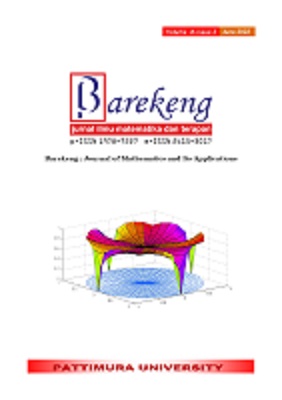STATISTICAL CONTROL ANALYSIS OF THE STUDENT’S FINAL ASSIGNMENT COMPLETION PERIOD AT THE MATHEMATICS AND NATURAL SCIENCES FACULTY
Abstract
The final assignment is one of the requirements to get a bachelor’s degree for college students at the Faculty of Mathematics and Natural Sciences (FMIPA) University of Lambung Mangkurat (ULM). The average period of completion of the final assignment in the year 2015 until 2019 is 8 months, while the determined specification by the guideline is 6 months. The aim of this research is to identify the quality control of the final assignment completion process and whether satisfy the determined specification using statistical quality control. The used data in this research is the student’s final assignment completion period (variable data) and the nonconforming proportion of data (attribute data). The and control charts are used for variable data and control chart for attribute data and process capability analysis. The result of variable data is that the average period of final assignment completion is statistically in control with a control limit of months. For attribute data concluded that final assignment completion is statistically in control with a big average proportion that is . For the capability analysis process by index and value sequentially is and for the DPU value is . This shows that the completion period of the student’s final assignment of FMIPA ULM is not capable to fulfill the specified standard of the period.
Downloads
References
A. Mitra, Fundamentals of Quality Control and Improvement, Fourth. New Jersey: John Wiley & Sons, Inc., 2016.
D. C. Montgomery, Introductoon to Statistical Quality Control, Sixth. United States: John Wiley & Sons, Inc., 2009.
M. J. Chandra, Statistical Quality Control. Florida: CRC Press LLC, 2001.
L. P. Alford and H. R. Beatty, Principal of Industrial Management, First. New York: The Ronald Press Company, 1951.
D. A. Melbourne, “A New method for Testing Normality based upon a Characterization of the Normal Distribution,” Florida International University, 2014.
M. A. Raheem, A. T. Gbolahan, and I. E. Udoada, “Application of Statistical Process Control in a Production Process,” Sci. J. Appl. Math. Stat., vol. 4, no. 1, pp. 1–11, 2016.
J. S. Oakland, Statistical Process Control, Fifth. Great Britain: Butterworth-Heinemann, 2003.
V. Gaspersz, Pedoman Implementasi Program: Six Sigma Terintegrasi dengan ISO 9001:2000, MBNQA, dan HACCP. Jakarta: PT Gramedia Pustaka Utama, 2002.
C. Okorie, O. Adubisi, and B. O.J, “Statistical Quality Control of the Production Materials in Life,” FUW Trends Sci. Technol. J., vol. 2, no. 1, pp. 69–73, 2017.
H. S. Ratna, H. Tannady, “Process Capability Analysis Pada NUT (Studi Kasus: PT Sankei Dharma Indonesia),” J@ti Undip: Jurnal Teknik Industri, vol. 12, no. 2, pp. 137–142, 2017.
R. Goonatilake, “Statisical Quality Control Approaches to Network Intrusion Detection,” Int. J. Network and its Application IJNSA, vol. 3, no. 6, pp. 115–124, 2011.
G. Smith, Statistical Process Control and Quality Control Improvement, Pretience Hall, 1998.
M. Yona, and H. Tannady, “Analisis Kinerja Proses Latex Dipping Menggunakan Teknik Capability Process,” Jurnal Ilmiah Teknik Industri, vol. 2, no. 14, pp. 105–112, 2014.
M. Xie, and T. Goh, “Statistical Techniques for Quality,” The TQM Magazine, vol. 4, no. 11, pp. 238–242, 1999.
W. Yerriswamy, et. al, “The Process Capability Analysis A Tool for Process Performance Measure and Metrics A Case Study,” The International Journal for Quality Research, vol. 3, no. 8, pp. 399–416, 2014.
Authors who publish with this Journal agree to the following terms:
- Author retain copyright and grant the journal right of first publication with the work simultaneously licensed under a creative commons attribution license that allow others to share the work within an acknowledgement of the work’s authorship and initial publication of this journal.
- Authors are able to enter into separate, additional contractual arrangement for the non-exclusive distribution of the journal’s published version of the work (e.g. acknowledgement of its initial publication in this journal).
- Authors are permitted and encouraged to post their work online (e.g. in institutional repositories or on their websites) prior to and during the submission process, as it can lead to productive exchanges, as well as earlier and greater citation of published works.






1.gif)



